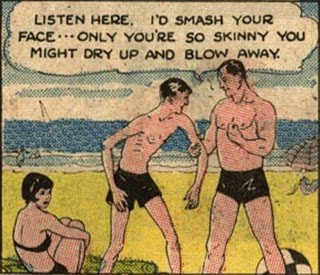The Sun Belt Is Tired Of Gettin’ Pushed Around
Posted by jstevrtc on October 27th, 2010Having had sand kicked in its face for long enough, the Sun Belt Conference has taken a long, cold look at itself in the mirror, and decided that it’s time to hit the gym.
On Monday, the conference announced that it planned to implement rules designed to increase the conference’s RPI rating. Specifically, the Sun Belt will mandate that its member basketball schools must only schedule non-conference opponents that, as ESPN.com’s Andy Katz reported, have a “three-year combined power rating within the top 150,” and/or teams that ended the previous season with an RPI within the top 150. The scheduling of games against non-Division I teams will be forbidden, and programs must constantly endeavor to average an attendance that surpasses the national average of 5,038 fans per game (as Katz reports, the Sun Belt brass are planning to help with this). The theory is that this scheduling upgrade en masse will raise the Sun Belt’s conference RPI and, in doing so, might lead to more than the single auto-qualifier each year in the NCAA Tournament, or at least a higher NCAA seed for the conference tournament winner. This would seemingly lead to other positive effects that all conferences love, like rising attendance at games, an increased television profile, and — to put it frankly — more respect. The rules outlined above will take effect starting in the 2011-12 season.
The Sun Belt is certainly ripe for a drastic self-determined change, meaning one that’s not being executed just to keep the conference alive. The great Sun Belt schism happened in the off-season of 1991, when most of the conference’s members bolted for other leagues and the remaining schools had to merge with the American South Conference to keep the Sun Belt in existence. Since that time, the Sun Belt has had more than one representative — its conference tournament winner — in the Big Dance exactly three times: 2008 (#10 South Alabama, at large; #12 Western Kentucky, auto), 1994 (#11 Western Kentucky, at large; #11 Louisiana-Lafayette, auto), and 1993 (#7 Western Kentucky, auto; #8 New Orleans, at large). Note that long drought, there — the span from 1995 to 2007 represents thirteen consecutive tournaments in which the Sun Belt was a single-bid league. And they logged only one win in that interval (#8 Western Kentucky def. #9 Michigan, 1995). In terms of actual conference RPI, the Sun Belt finished last year at its 10-year nadir of 22nd out of 32 conferences, averaging a year-end rank of 17.5 over that time period.
Though one has to commend the good intentions of the Sun Belt’s honchos and what they’re trying to accomplish with the new rules, the member schools might find them difficult ones with which to comply. Teams from the major conferences don’t exactly jump at the chance to play home-and-home games with schools from smaller conferences in consecutive years, preferring instead to host the smaller school one year (almost always an automatic win for the big school) and cut them a big check instead of returning the favor by traveling to the smaller school’s gym the next year and giving them the chance to swing up at the big program on home ground. In order to adhere to the new rules, then, Sun Belt teams might find themselves playing more road games against higher profile opponents, which, as much as it might beef up their bank accounts by snagging lots of guarantees, can’t be good for winning percentages (a rather large component of a team’s RPI). Reaching that national average of 5,038 fans in attendance won’t be easy, either, since the average attendance over all games played by Sun Belt teams last year was a mere 2,451, a number that would have to more than double to reach the desired level.
This isn’t a mindless action by the Sun Belt. There is some prior evidence that, if the goal is to raise conference RPI, what the Sun Belt is doing actually works. This very league has tried this before, instituting similar scheduling requirements from 2003 to 2005 which resulted in a year-end RPI rank of 13th in 2005 — its best result over the last ten seasons. Before the 2001-02 season, the Missouri Valley Conference gave its member schools $50,000 apiece if they finished the season in the top half of the RPI rankings, or if their non-conference opponents did the same. In 2001-02, the MVC’s RPI ended the season ranked 14th. For the last six seasons, the conference has finished the season with an RPI between 6th and 9th. Because the MVC’s schools had improved their non-conference scheduling so much, the incentives were discontinued after two years.
The most important question is the one Katz raises at the end of the linked article above, and that’s whether or not a good conference RPI matters to the NCAA when it comes to which individual teams are in or out. Last season, NCAA selection committee chairman Dan Guerrero stated that, while the RPI of each individual team means a lot, any metric that compares one conference to another is “not a factor,” and was “no longer on the team sheet,” that single sheet of paper with all the numerical data summarizing a squad’s achievements that’s used by the committee when they create the bracket every year. The MVC’s RPI may have improved since they incentivized their teams back in 2001, but even though they spiked with four NCAA Tournament teams in 2006, they’ve been a one-bid league for the past four tournaments despite a conference RPI in the top ten. During the years that the Sun Belt previously attempted similar measures to the ones they’ve just introduced, they were never better than a one-bid/zero-win league.
The thinking here is that a rising tide will lift all boats, that if the Sun Belt’s profile starts to measure up better when compared to other conferences as evidenced by a rising conference RPI ranking, then good things will follow — but what are those good things? That conference RPI number might look nice, but if it doesn’t lead to more NCAA Tournament bids and therefore more NCAA Tournament wins…is it really worth it?












































These moves (scheduling requirements, attendance requirements) are not aimed at boosting the RPI. They are aimed at (A) getting rid of weak members (e.g., Denver, UALR) and attracting stronger replacements (e.g, La Tech).